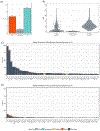The Genomic Landscape of Merkel Cell Carcinoma and Clinicogenomic Biomarkers of Response to Immune Checkpoint Inhibitor Therapy
- PMID: 31399473
- PMCID: PMC6774882
- DOI: 10.1158/1078-0432.CCR-18-4159
The Genomic Landscape of Merkel Cell Carcinoma and Clinicogenomic Biomarkers of Response to Immune Checkpoint Inhibitor Therapy
Abstract
Purpose: Merkel cell carcinoma (MCC) is a rare, aggressive cutaneous malignancy, which has demonstrated sensitivity to immune checkpoint inhibitor therapy. Here, we perform the largest genomics study in MCC to date to characterize the molecular landscape and evaluate for clinical and molecular correlates to immune checkpoint inhibitor response.
Experimental design: Comprehensive molecular profiling was performed on 317 tumors from patients with MCC, including the evaluation of oncogenic mutations, tumor mutational burden (TMB), mutational signatures, and the Merkel cell polyomavirus (MCPyV). For a subset of 57 patients, a retrospective analysis was conducted to evaluate for clinical and molecular correlates to immune checkpoint inhibitor response and disease survival.
Results: Genomic analyses revealed a bimodal distribution in TMB, with 2 molecularly distinct subgroups. Ninety-four percent (n = 110) of TMB-high specimens exhibited an ultraviolet light (UV) mutational signature. MCPyV genomic DNA sequences were not identified in any TMB-high cases (0/117), but were in 63% (110/175) of TMB-low cases. For 36 evaluable patients treated with checkpoint inhibitors, the overall response rate was 44% and response correlated with survival at time of review (100% vs. 20%, P < 0.001). Response rate was 50% in TMB-high/UV-driven and 41% in TMB-low/MCPyV-positive tumors (P = 0.63). Response rate was significantly correlated with line of therapy: 75% in first-line, 39% in second-line, and 18% in third-line or beyond (P = 0.0066). PD-1, but not PD-L1, expression was associated with immunotherapy response (77% vs. 21%, P = 0.00598, for PD-1 positive and negative, respectively).
Conclusions: We provide a comprehensive genomic landscape of MCC and demonstrate clinicogenomic associates of immunotherapy response.
©2019 American Association for Cancer Research.
Conflict of interest statement
Figures



References
-
- Fitzgerald TL, Dennis S, Kachare SD, Vohra NA, Wong JH, Zervos EE. Dramatic Increase in the Incidence and Mortality from Merkel Cell Carcinoma in the United States. Am Surg 2015;81(8):802–6. - PubMed
Publication types
MeSH terms
Substances
Grants and funding
LinkOut - more resources
Full Text Sources
Medical
Research Materials

